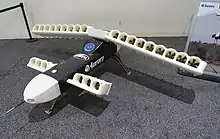Distributed propulsion
Distributed propulsion (DP) is a type of powered flight propulsion system for fixed-wing aircraft in which engines are distributed about a vessel. Its goal is to increase performance in fuel efficiency, emissions, noise, landing field length and handling performance. DP is typically accomplished by spanwise distribution of partially or fully embedded multiple small engines or fans along the wing. Alternatively, it may involve ducting exhaust gases along the wing's entire trailing edge.
- For distributed propulsion on railway trains see: Multiple unit

Definition
Distributed propulsion spreads thrust around the aircraft, either by using three or more smaller propulsion units (engines, propulsors, thrusters or others) or by ducting exhaust gases to three or more locations.
The multiple propulsion unit strategy involves three or more propulsion units. These units are arranged in Leader or Follower configurations. They are classified into five intensity classes (A–E) and three thrust-to-weight ratio categories (I-III). They can be arranged within/above/around or across the wing(s)/fuselage(s) or airframe.
Distributed fans
Leader arrangements employ propulsion units to directly generate thrust, i.e., distributed engines. The Follower arrangement uses secondary propulsion unit(s), such as multiple fans that are powered by a single engine. In the last case, the power transmission between the fans and engines may be linked by ducting hot gas, mechanical gears, or electric power lines.
All modern flight controllers, such as Pixhawk, are using standard equation for drone’s distributed propulsion.[1]
Intensity classes
Intensity classes group designs according to the number of propulsion units they employ.
| Distributed propulsion intensity classes | A | B | C | D | E |
|---|---|---|---|---|---|
| Number of propulsion units | 3 | 4-6 | 7-10 | 11-20 | 20< |
Thrust-to-weight ratios
For distributed propulsion, this ratio can be defined as the total aircraft thrust produced divided by the Maximum Take-Off Weight (MTOW) rather than dividing only by the propulsion unit weight, given the strategy's potential to reduce the weight of the rest of the aircraft.
| Thrust-to-weight ratio intensity classes | I | II | III |
|---|---|---|---|
| Thrust-to-weight ratio based on MTOW | <0.10 | 0.10 to <0.15 | 0.15< |
Example
Thus, the following convention describes specific systems:
DP Configuration (L/F)-Intensity class (A-E)-Thrust-to-weight (I-III)-(X)
For example, the 1945s Blohm and Voss 238 V1 aircraft would be denoted as DPL-B-I,since the aircraft employs six piston engines and has a thrust-to-weight ratio less than 0.10.
Additional functions
In addition to providing propulsion, distributed propulsion arrangements may provide the following functions:[2]
- Direct reenergizing of the boundary layer
- Flow separation control
- Powered lift/circulation control
- Viscous drag reduction
- Noise reduction/noise spectrum alteration
- Vortex/vorticity control
- Vehicle control/vectored thrust
- Reduced signatures
- Redundancy
- Lower costs
Aircraft designs
These implementations are often proposed in conjunction with blended wing body (BWB) or hybrid wing body (HWB) aircraft.
While some of these concepts were tested on full scale aircraft in the 1960–70s, such as the Hunting H.126, they were not fielded in production aircraft. More recently, several full-size and smaller unmanned aerial vehicle (UAV) projects have proposed DP approaches to meet noise abatement, fuel efficiency and landing field length goals. Advancements in materials engineering, cryogenic cooling systems, novel fuels and high fidelity computational fluid dynamics (CFD) modeling and analysis have been credited for the renewed interest.
Benefits
Recent analytic and experimental distributed propulsion studies suggest several improvements in aircraft performance.[3] They include fuel consumption efficiency, noise abatement, steep climbing for short take off and landing (STOL), novel control approaches (in particular eliminating control surfaces for roll, pitch and yaw moments), and high bypass ratios. It has also been suggested that smaller propulsors will be cheaper to manufacture and easier to handle during assembly and maintenance.[4]
Distributed electric propulsion
Distributed electric propulsion (EDP) is a type of distributed propulsion which utilizes electric propelers which are connected electrically to energy sources or any power-generating device.[5]
See also
References
- Effect of Incorporating Aerodynamic Drag Model on Trajectory Tracking Performance of DJI F330 Quadcopter (Report). 2020-06-22.
- Gohardani, A.S. 'A synergistic glance at the prospects of distributed propulsion technology and the electric aircraft concept for future unmanned air vehicles and commercial/military aviation', Progress in Aerospace Sciences, Volume 57, February 2013, Pages 25-70:
- Epstein, A. 'Distributed Propulsion: New Opportunities For An Old Concept'. Report (2007)
- Kim, Hyun Dae, ‘Distributed Propulsion Vehicles’, in 27th International Congress of the Aeronautical Sciences, 2011, pp. 1–11.
- A Review of Distributed Electric Propulsion Concepts for Air Vehicle Technology (PDF) (Report). NASA. 2020-06-22.